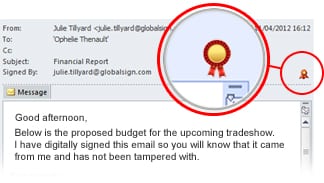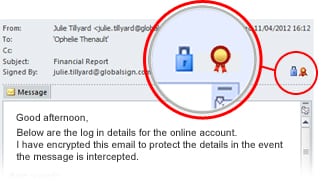A PersonalSign Digital Certificate is a Digital ID issued to an entity (i.e. individual or a department) that helps to prove that entity’s identity. The Digital ID binds an individual’s verified identity (typically including the name, company name and email address of the Digital ID owner) to a unique cryptographic credential. PersonalSign Certificates identify, prove and contain different levels of information which are defined as classes.
Each class represents the level of identity verification – from simple email verification to full identity assurance. PersonalSign Certificates allow individuals and organizations to represent their digital identities through the use of digital signatures in many applications – from secure email to two-factor authentication to document signing.
How to Use PersonalSign Certificates
PersonalSign certificates can be used for:
- Strong Authentication to networks, VPNs, cloud services & more.
- Secure Email- (S/MIME)- Digitally Sign & Encrypt Email
- Digitally Sign Microsoft Office Documents
Two Factor Authentication:
Client Authentication is the process by which users securely access a server or remote computer by exchanging a Digital ID. Networks and web services can be configured to only allow access to particular Digital IDs. Authentication prevents unauthorized access and enhances current security. It can be used for in-browser client authentication to VPNs, smart card technology, cloud applications, and mobile devices. PersonalSign Certificates have approved Digital Certificates for various online services including the FDA ESG and NAESB Electronic Industry Registry.
Secure Email:
PersonalSign Certificates use Secure/Multipurpose Internet Mail Extensions (S/MIME) technology to allow users to digitally sign and encrypt email. Digitally signing emails protects the origin and authenticity of an email. A digital signature (different from a “message signature” or customizable salutation) adds a unique code to a message which only comes from the Digital ID of the original sender. It also confirms that the content of the email has not been altered in transit. Encrypting email ensures message privacy. Encrypting email converts the message into (scrambled) ciphertext. Only the intended recipient (who is the owner of the corresponding private key*) can “unlock” the message and view the content in clear text.
*Both the sender and the recipient must have a digital certificate to use email encryption.
-

-
Digitally Signed Email:
Proves authorship & prevents tampering
-

-
Encrypted Email:
Ensures message privacy
Microsoft Office Document Signing:
GlobalSign PersonalSign Digital IDs are trusted by Microsoft Office systems and allow you to create digital signatures. Applying a digital signature to a document proves the information originated with the signer and that the document has not been altered since the document was signed, ensuring document integrity. This allows for secure electronic document workflows, eliminates time and resources spent by replacing paper-based workflows. It also meets compliance requirements associated with electronic workflows. When applying a digital signature, you can choose to insert an image file containing a handwritten signature or other images of choice.





